
Once called the “German Marie Curie” by Albert Einstein, Lise Meitner was an Austrian-Swedish physicist who studied radioactivity and nuclear physics. Her joint research with the chemists Otto Hahn and Fritz Strassmann led to the discovery of the element protactinium and nuclear fission.
Born in 1878, Elise (she later shortened her name to Lise) was the third of eight children born to a Jewish lawyer, Philipp Meitner, and his wife Hedwig. As a child, she was particularly drawn to math and science. While she was raised to be a freethinker, she studied physics privately, with the support of her parents, because public universities in Germany at the time did not admit women. She entered the University of Vienna in 1901, continuing her studies under Ludwig Boltzmann, and in 1905 she became just the second woman to earn a doctoral degree.
In 1907, Meitner moved to Berlin and became a lab assistant to Max Planck, who was notoriously reluctant to teach women, and began a collaboration with Otto Hahn that would span 30 years and lead them to the discovery of several new isotopes. She moved with Hahn to the Kaiser Wilhelm Institute in 1912, initially working without pay, and in 1917 was granted her own physics lab. A year later, the duo discovered the element protactinium.
Meitner went on to discover the radiationless transition known as the Auger effect in 1923, which is named for Pierre Victor Auger, a French scientist who discovered the effect independent of her. When she moved to the University of Berlin in 1926 to head a research program in nuclear physics, she became the first woman in Germany to hold a full professorship. She remained at the Institute for Chemistry until 1938, when she was forced to flee Germany for Sweden because of her Jewish background.
Meitner continued her work at Manne Siegbahn’s laboratory in Stockholm, meeting secretly with Hahn for new rounds of experiments. In 1939, she published the physical explanation for the observations and, with her nephew, physicist Otto Frisch, named the process nuclear fission. While ignored for the Nobel Prize because Hahn downplayed her role and, in a controversial decision, did not list her as a co-author of the research, she was awarded the Enrico Fermi Award as a partial rectification in 1966.
Meitner retired to Cambridge, England, in 1960, where she died eight years later. In 1992, element 109 was named Meitnerium (Mt) in her honor — the only element named specifically for a single non-mythological woman (Curium was named after both Pierre and Marie Curie).
